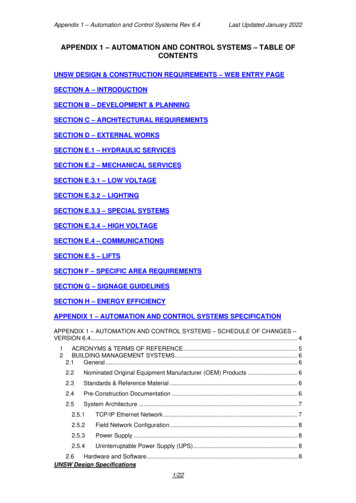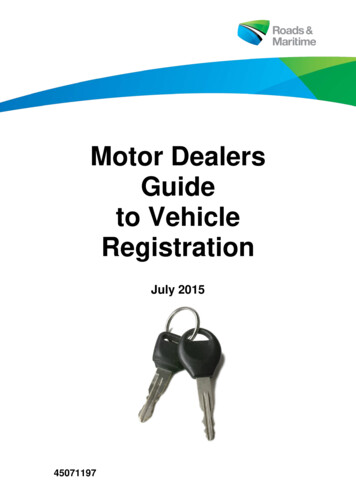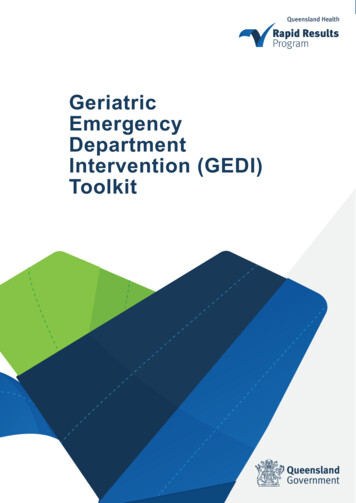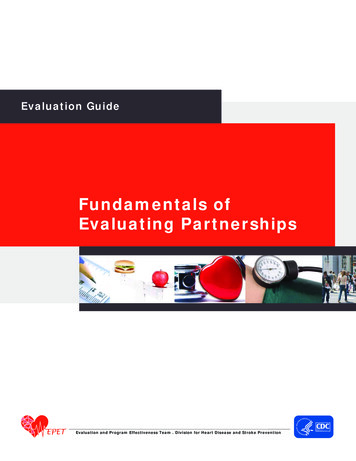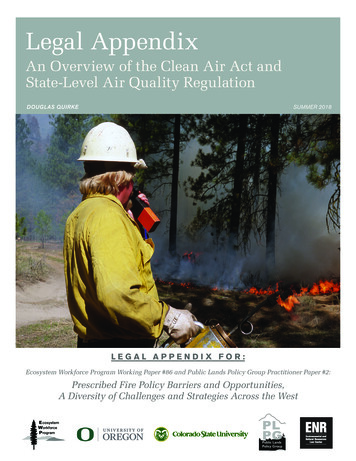
Transcription
Legal AppendixAn Overview of the Clean Air Act andState-Level Air Quality RegulationSUMMER 2018DOUGLAS QUIRKELEGAL APPENDIX FOR:Ecosystem Workforce Program Working Paper #86 and Public Lands Policy Group Practitioner Paper #2:Prescribed Fire Policy Barriers and Opportunities,A Diversity of Challenges and Strategies Across the WestE cosystemWorkforceP rogramPLPGPublic LandsPolicy Group
About the authorsDouglas Quirke is a Research Associate at the University of Oregon School of Law’s Environmental &Natural Resources Law Center.AcknowledgementsAlyssa Bonini and Daniel Lawler, Fellows at the University of Oregon School of Law’sEnvironmental & Natural Resources Law Center, provided valuable assistance and research for thecontent of this legal review.This research was made possible with funding from the Joint Fire Science Program (#16-1-02-8).All photos are public domain from U.S. Forest Service and USDA Flickr sites.For more information about this report or this research, contact:Courtney SchultzPublic Lands Policy GroupDepartment of Forest and Rangeland StewardshipColorado State UniversitFort Collins, CO ercnr.colostate.edu/courtneyschultz/Heidi Huber-StearnsEcosystem Workforce ProgramInstitute for a Sustainable Environment5247 University of OregonEugene, OR e University of Oregon is an equal-opportunity, affirmative-action institution committed to cultural diversity and compliance with the Americans withDisabilities Act. This publication will be made available in accessible formats upon request. 2018 University of Oregon.
Legal Appendix: An Overview of the Clean Air Act and State-Level Air Quality Regulation1Legal Appendix: An Overview of the Clean Air Act andState-Level Air Quality RegulationThis document serves as an appendix to theUniversity of Oregon Ecosystem WorkforceProgram Working Paper #86 and ColoradoState University Public Lands Policy Group Practitioner Paper #2, completed in collaboration withthe University of Oregon School of Law’s Environmental & Natural Resource Law Center, and entitled“Prescribed Fire Policy Barriers and Opportunities:A Diversity of Challenges and Strategies Across theWest.” The report is available at https://ewp.uoregon.edu/publications/working. The report and thisappendix are products of a Joint Fire Science Program project (16-1-02-8) investigating policies thatlimit managers’ ability to conduct prescribed fire onUS Forest Service and Bureau of Land Managementlands in the eleven Western states. The primaryobjectives of this project are to:1. Identify current perceived policy barriers toimplementing prescribed fire and how thesevary across the West, and2. Characterize actionable opportunities andmechanisms for overcoming barriers.The aforementioned report details our findingsfrom our initial phases of project research, including a legal analysis and approximately sixty interviews with key informants (e.g. land managers, airregulators, and state agency partners). This appendix provides additional detail from our legal research on air quality law and policy. The followingsections include overviews of the federal Clean AirAct, followed by details for each of the 11 westernstates in our study. In the main report (WorkingPaper #86 available at https://ewp.uoregon.edu/publications/working), Table 1 on pp. 14-16 providesa state-by-state overview of air quality regulatoryprocesses and interagency relationships to supportburning in each state; please refer to the table for aquick reference guide that summarizes the information for states covered in this appendix.
Legal Appendix: An Overview of the Clean Air Act and State-Level Air Quality Regulation2Table of ContentsI. Prescribed Fire and the Federal Clean Air Act . . . . . . . . . . . . . . . . . . . . . . . . . . . . . . . 3A. Overview . . . . . . . . . . . . . . . . . . . . . . . . . . . . . . . . . . . . . . . . . . . . . . . . . . . . . . . . . . . . . . . . . . . . . . . . . . . . . . . . . 3B. Exclusion of Prescribed Fire Emissions from SIP and Attainment/Nonattainment Determinations . . . . . . . . 3C. Prescribed Fire Emissions and Visibility/Regional Haze . . . . . . . . . . . . . . . . . . . . . . . . . . . . . . . . . . . . . . . . . . . 6D. Conclusion . . . . . . . . . . . . . . . . . . . . . . . . . . . . . . . . . . . . . . . . . . . . . . . . . . . . . . . . . . . . . . . . . . . . . . . . . . . . . . . 9II. Summary of State Prescribed Fire Laws in Eleven Western States . . . . . . . . . . . . . 10A. Arizona . . . . . . . . . . . . . . . . . . . . . . . . . . . . . . . . . . . . . . . . . . . . . . . . . . . . . . . . . . . . . . . . . . . . . . . . . . 10B. California . . . . . . . . . . . . . . . . . . . . . . . . . . . . . . . . . . . . . . . . . . . . . . . . . . . . . . . . . . . . . . . . . . . . . . . . . . . . . . . . 16C. Colorado . . . . . . . . . . . . . . . . . . . . . . . . . . . . . . . . . . . . . . . . . . . . . . . . . . . . . . . . . . . . . . . . . . . . . . . . . . . . . . . . 20D. Idaho . . . . . . . . . . . . . . . . . . . . . . . . . . . . . . . . . . . . . . . . . . . . . . . . . . . . . . . . . . . . . . . . . . . . . . . . . . . . . . . . . . . 26E. Montana . . . . . . . . . . . . . . . . . . . . . . . . . . . . . . . . . . . . . . . . . . . . . . . . . . . . . . . . . . . . . . . . . . . . . . . . . . . . . . . . 29F.Nevada . . . . . . . . . . . . . . . . . . . . . . . . . . . . . . . . . . . . . . . . . . . . . . . . . . . . . . . . . . . . . . . . . . . . . . . . . . . . . . . . . 32G. New Mexico . . . . . . . . . . . . . . . . . . . . . . . . . . . . . . . . . . . . . . . . . . . . . . . . . . . . . . . . . . . . . . . . . . . . . . . . . . . . . 35H. Oregon . . . . . . . . . . . . . . . . . . . . . . . . . . . . . . . . . . . . . . . . . . . . . . . . . . . . . . . . . . . . . . . . . . . . . . . . . . . . . . . . . 38I.Utah . . . . . . . . . . . . . . . . . . . . . . . . . . . . . . . . . . . . . . . . . . . . . . . . . . . . . . . . . . . . . . . . . . . . . . . . . . . . . . . . . . . . 41J.Washington . . . . . . . . . . . . . . . . . . . . . . . . . . . . . . . . . . . . . . . . . . . . . . . . . . . . . . . . . . . . . . . . . . . . . . . . . . . . . . 45K. Wyoming . . . . . . . . . . . . . . . . . . . . . . . . . . . . . . . . . . . . . . . . . . . . . . . . . . . . . . . . . . . . . . . . . . . . . . . . . . . . . . . . 47
Legal Appendix: An Overview of the Clean Air Act and State-Level Air Quality RegulationI.Prescribed Fire and The Federal Clean Air ActA. OverviewThe federal Clean Air Act requires the federal Environmental Protection Agency (EPA) toestablish National Ambient Air Quality Standards (NAAQS), while “states have the primaryresponsibility for achieving and maintaining” these standards.1 The EPA has establishedstandards for carbon monoxide, lead, nitrogen dioxide, ozone, particle pollution, and sulfurdioxide,2 and states must outline their strategies for achieving, enforcing, and maintainingthese standards via “state implementation plans” (SIPs) covering each of these pollutants.3The Clean Air Act and implementing regulations (promulgated by the federal EPA) establishminimum standards for SIPs, with differing “requirements and procedures . . . triggereddepending on the degree of attainment or nonattainment of the NAAQS.”4 Areas aredesignated as “attainment,” “nonattainment,” or “unclassifiable” based on availableinformation,5 with carbon monoxide and particle pollution nonattainment areas furtherclassified as “moderate” or “serious,” and ozone nonattainment areas further classified inone of six categories ranging from “marginal” to “extreme.”6 SIP requirements fornonattainment areas vary depending on degree of nonattainment.7B. Exclusion of Prescribed Fire Emissions from SIP andAttainment/Nonattainment DeterminationsIn November of 2015, the EPA proposed a revised version of its “Exceptional EventsExclusion Rule,” which exempts emissions from qualifying prescribed fires from NAAQSviolations and the consequences those NAAQS violations would otherwise have (such as redesignation of an attainment area to a non-attainment area).8 The revised rule was finalizedin October of 2016, with an effective date of September 30, 2016.9The EPA’s Exceptional Events Exclusion Rule allows a “State, federal land manager orother federal agency”10 to request that the EPA exclude “data showing exceedances or1The Clean Air Act Handbook at 49.See table3Handbook at 49.4Handbook at 49.5Handbook at 51.6Handbook at 85 (carbon monoxide), 79 (particle pollution), 68 (ozone).7See Handbook at 64-86.880 Fed. Reg. 72,840 (November 20, 2015).981 Fed. Reg. 68,216 (October 3, 2016) (codified at 40 CFR §§ 50.1(j),(k) & (m) through (r)(“Definitions”), 50.14 (“Treatment of air quality monitoring data influenced by exceptionalevents”) and 51.930 (“Mitigation of Exceptional Events”)).10A “federal land manager or other federal agency” may initiate a data exclusion request onlyafter the state in which the affected air quality monitor is located concurs with the federalsubmittal. 40 CFR § 50.14(a)(1)(ii)(A)(2). The proposed rule allowed federal land managersto initiate exclusion requests without state concurrence, however this was dropped in the23
Legal Appendix: An Overview of the Clean Air Act and State-Level Air Quality Regulationviolations” of NAAQS “from use in determinations” when those exceedances or violationswere “directly due to an exceptional event.”11 The particular “regulatory determinations”encompassed by the rule are as follows: Actions designating areas as “attainment,” “nonattainment,” or “unclassifiable” forparticular NAAQS;Actions redesignating areas to different designation (e.g., from “attainment” to“nonattainment” or vice versa);“The assignment or re-assignment of a classification category to a nonattainmentarea” (e.g., reassignment of a carbon monoxide nonattainment area classified as“moderate” to a classification of “serious”);Determinations “regarding whether a nonattainment area has” achieved a specifiedNAAQS level by a particular deadline;Determinations that NAAQS data for a particular area “qualify the area for anattainment date extension;”Determinations based on NAAQS violations that a SIP is inadequate; and“Other actions on a case-by-case basis as determined by the Administrator.”12Requesters of exceptional event data exclusions must demonstrate to the EPA’s satisfactionthat the particular event “caused a specific air pollution concentration at a particular airquality monitoring location.”13 Exclusion requests must include the following information: “A narrative conceptual model that describes the event(s) causing the exceedance orviolation and a discussion of how emissions from the event(s) led to the exceedanceor violation at the affected monitor(s);”14 “A demonstration that the event affected air quality in such a way that there exists aclear causal relationship between the specific event and the monitored exceedance orviolation;”15final rule in light of the fact that “the large majority of commenters disagreed with th[e]proposed provision.” 81 Fed. Reg. 68,223. “State and local air agencies, as well as severalregional planning organizations, commented that it is inappropriate for the EPA to allowagencies that are not directly responsible and accountable for managing and/or assuring airquality to submit exceptional event demonstrations or data exclusion requests.” Id.1140 CFR § 50.14(a)(1)(ii).1240 CFR § 50.14(a)(1)(i)(A)-(F). Prior to the 2016 amendments, the rule did not specifywhat “determinations” were covered by the rule.1340 CFR § 50.14(a)(1)(ii).1440 CFR § 50.14(c)(3)(iv)(A).1540 CFR § 50.14(c)(3)(iv)(B).4
Legal Appendix: An Overview of the Clean Air Act and State-Level Air Quality Regulation “Analyses comparing the claimed event-influenced concentration(s) toconcentrations at the same monitoring site at other times to support the [preceding]requirement;”16 “A demonstration that the event was both not reasonably controllable and notreasonably preventable;”17 and “A demonstration that the event was a human activity that is unlikely to recur at aparticular location or was a natural event.”18Exclusion requests must also document that the requester followed a prescribed publiccomment process,19 and must include public comments received.20 The exclusion requestmust specifically address “those comments disputing or contradicting factual evidenceprovided in” the exclusion request.21Prescribed fires can qualify for exceptional event exclusion when they are shown to be notreasonably controllable, not reasonably preventable, and not likely to recur at a particularlocation. The rule spells out how prescribed fires can meet these requirements. In order for aprescribed fire to be considered “not reasonably controllable,” “the State must either certifyto [the EPA] that it has adopted and is implementing a smoke management program or . . .that the burn manager employed appropriate basic smoke management practices.”22In order for a prescribed fire to meet the “not reasonably preventable” criterion,the State may rely upon and reference a multi-year land or resourcemanagement plan for a wildland area with a stated objective to establish,restore and/or maintain a sustainable and resilient wildland ecosystemand/or to preserve endangered or threatened species through a program ofprescribed fire provided that the Administrator determines that there is nocompelling evidence to the contrary in the record and the use of prescribedfire in the area has not exceeded the frequency indicated in that plan.23Finally, with regard to the requirement that a prescribed fire must be “unlikely to recur at aparticular location,” “the State must describe the actual frequency with which a burn wasconducted,” but similar to the “not reasonably preventable” requirement, the state1640 CFR § 50.14(c)(3)(iv)(C).40 CFR § 50.14(c)(3)(iv)(D).1840 CFR § 50.14(c)(3)(iv)(E).1940 CFR § 50.14(c)(3)(v)(A).2040 CFR § 50.14(c)(3)(v)(B).2140 CFR § 50.14(c)(3)(v)(C).2240 CFR § 50.14(b)(3)(ii)(A). “Basic smoke management practices” are identified in Table 1of rule.2340 CFR § 50.14(b)(3)(ii)(C).175
Legal Appendix: An Overview of the Clean Air Act and State-Level Air Quality Regulationmay rely upon and reference an assessment of the natural fire return intervalor the prescribed fire frequency needed to establish, restore and/or maintaina sustainable and resilient wildland ecosystem contained in a multi-year landor resource management plan with a stated objective to establish, restoreand/or maintain a sustainable and resilient wildland ecosystem and/or topreserve endangered or threatened species through a program of prescribedfire.24Distilled to its essence, the EPA’s Exceptional Events Exclusion Rule allows for exclusionof prescribed fire emissions data from various SIP/attainment/nonattainment-relateddeterminations when emissions from prescribed fires trigger exceedances or violations of airquality standards. In order to qualify for such exclusion, smoke management must beemployed, and prescribed fires must be properly included in land or resource managementplans. However, the implication of this regulation is not that prescribed fire can be plannedto trigger an exceedance.C. Prescribed Fire Emissions and Visibility/Regional HazeCongress amended the Clean Air Act in 1977 to include a requirement that SIPs include “along-term (ten to fifteen year) strategy for making reasonable progress toward meeting thenational goal”25 of preventing future/remedying existing “impairment of visibility inmandatory class I federal areas.”26 Class I areas primarily consist of wilderness areas over5,000 acres in size and national parks over 6,000 acres in size.27 In 1980, the EPApromulgated regulations implementing the 1977 visibility amendments while at the sametime “explicitly defer[ing] action on regional haze . . . until some future date whenimprovement in monitoring techniques provided more data on source-specific levels ofvisibility impairment, regional scale models became refined, and our scientific knowledgeabout the relationships between emitted air pollutants and visibility impairment improved.”28Congress subsequently amended the Clean Air Act in 1990 to address regional haze,requiring “the promulgation of regulations . . . to address long range strategies for addressingregional haze which impairs visibility in affected class I areas.”29 Regional haze is “visibility2440 CFR § 50.14(b)(3)(iii).42 U.S.C. § 7491(b)(2)(B).2642 U.S.C. § 7491(a)(1).2742 U.S.C. § 7472(a). There are a total of 108 such areas in the eleven western statescovered by this project. See 40 CFR §§ 81.403 (Arizona (12 areas)), 81.405 (California (29areas)), 81.406 (Colorado (12 areas)), 81.410 (Idaho (5 areas)), 81.417 (Montana (12 areas))81.418 (Nevada (1 area)), 81.421 (New Mexico (9 areas)), 81.425 (Oregon (12 areas)), 81.430(Utah (5 areas)), 81.434 (Washington (8 areas)), and 81.436 (Wyoming (7 areas)). Note thatsome areas occur in multiple states, and the total of 108 has been adjusted so as to accountfor these areas just once. Expressed as a percentage, over sixty nine percent of class I areasare in this eleven state region.2881 Fed. Reg. 26,945 (May 4, 2016).2942 U.S.C. 7492(d)(2)(C).256
Legal Appendix: An Overview of the Clean Air Act and State-Level Air Quality Regulationimpairment that is produced by a multitude of sources and activities that are located across abroad geographic area and emit PM10, PM2.5 (e.g., sulfates, nitrates, organic carbon,elemental carbon and soil dust) and their precursors (e.g., SO2, NOX and, in some cases,ammonia and volatile organic compounds).”30The EPA promulgated the required regulations in 1999, and they require implementationplans for regional haze. The 1999 regulations provided two primary pathways for states toaddress regional haze during the initial regional haze implementation period.31 The firstpathway (“308”32) was open to all states, while the second pathway (“309”33) was analternative pathway open to nine “transport region states,”34 and applied to “regional hazevisibility impairment in the 16 Class I areas covered by the [June 10, 1996] Grand CanyonVisibility Transport Commission Report.” It appears that only New Mexico, Utah, andWyoming chose the 309 pathway.35 The 309 pathway allowed transport region states toachieve compliance with the haze regulations by implementing the recommendations of theGrand Canyon Visibility Transport Commission contained in the aforementioned report.With regard to prescribed fire, the 309 pathway requires that haze implementation plansinclude the following:30 Documentation that prescribed fire programs in the state (whether federal, state, orprivate) “evaluate and address . . . visibility impairment;” “smoke management programs that include all necessary components including, butnot limited to, actions to minimize emissions, evaluation of smoke dispersion,alternatives to fire, public notification, air quality monitoring, surveillance andenforcement, and program evaluation;” “A statewide inventory and emissions tracking system (spatial and temporal) ofVOC, NOX, elemental and organic carbon, and fine particle emissions from fire;”81 Fed. Reg. 26,942, 26,946 (2016).The initial haze implementation period for the 309 pathway is December 17, 2007 toDecember 31, 2018 (i.e., initial plans were due to the EPA by December 17, 2007 andconsisted of the submitting states’ strategies for addressing haze through the end of 2018).Until fairly recently, the initial implementation period for the 308 pathway was December 17,2007 through July 31, 2018, however the EPA extended the 2018 deadline to July 31, 2021.82 Fed.Reg. 3,078 (January 10, 2017) (“The EPA also is making a one-time adjustment to thedue date for the next periodic comprehensive SIP revisions by extending the existingdeadline of July 31, 2018, to July 31, 2021.”)3240 CFR § 51.308.3340 CFR § 51.309.34Arizona, California, Colorado, Idaho, Nevada, New Mexico, Oregon, Utah, and Wyoming.40 CFR § 51.309(b)(2).3581 Fed. Reg. 26,942, 26,950 (May 4, 2016). In addition to provisions pertaining toprescribed fire, the 309 pathway also includes provisions pertaining to stationary sources,mobile sources, and dust emissions from roads. 40 CFR §§ 51.309(d)(4), 51.309(d)(5),51.309(d)(7).317
Legal Appendix: An Overview of the Clean Air Act and State-Level Air Quality Regulation “Identification and removal wherever feasible of any administrative barriers to theuse of alternatives to burning;” “Enhanced smoke management programs for fire that consider visibility effects;”and “Establishment of annual emission goals for fire, excluding wildfire, that willminimize emission increases from fire to the maximum extent feasible.”36The regulations for implementation plans under the 308 pathway (chosen by the forty-sevenstates that did not choose the 309 pathway described above, and applicable to all fifty statesfor the comprehensive SIP revisions due by July 31, 2021) include the following “corerequirements:” Establishment of goals “that provide for reasonable progress towards achievingnatural visibility conditions,”37 as well as analysis and determination of “the rate ofprogress needed to attain natural visibility conditions by the year 2064;”38 and “[A] long-term strategy that addresses regional haze visibility impairment for eachmandatory Class I Federal area within the State and for each mandatory Class IFederal area located outside the State that may be affected by emissions from theState.”39These core implementation plan requirements appear to be the ones most relevant toprescribed fire emissions—the other core requirements are “[c]alculations of baseline andnatural visibility conditions,” and various monitoring, reporting, inventorying, andrecordkeeping requirements.40In January of 2017, the EPA finalized proposed amendments to the regulations governingthe requirements for visibility/haze implementation plans, and among the amendments wasone allowing states to “add the estimated impact(s) [from certain prescribed fires] to thenatural visibility condition” for purposes of determining the “uniform rate of progress”necessary to achieve the goal of natural visibility by 2064.41 In other words, this recentamendment allows emissions from certain prescribed fires to be treated as if they were3640 CFR § 51.309(d)(6).40 CFR § 51.308(d)(1).3840 CFR § 51.308(d)(1)(i)(B).3940 CFR § 51.308(d)(3). It should be noted that a significant portion of the regional hazeregulations is directed at stationary sources and “best available retrofit technology” (BART)requirements for such sources. Because these requirements do not apply to prescribed fire,they are outside the scope of this document.4040 CFR §§ 51.308(d)(2) & 51.308(d)(4).4140 CFR § 51.308(f)(1)(vi)(B).378
Legal Appendix: An Overview of the Clean Air Act and State-Level Air Quality Regulationnatural or non-anthropogenic.42 The particular prescribed fires to which this amendmentapplies are “wildland prescribed fires that were conducted with the objective to establish,restore, and/or maintain sustainable and resilient wildland ecosystems, to reduce the risk ofcatastrophic wildfires, and/or to preserve endangered or threatened species during whichappropriate basic smoke management practices were applied.”43 The EPA noted that suchprescribed fires “can be consistent with the goal of making reasonable progress towardsnatural visibility”44 and “can result in net beneficial impacts on visibility.”45 The EPA alsonoted that since the initial implementation of regional haze requirements “the few [Class Iareas] that have experienced degradation have not done so because of impacts attributable toprescribed fire,” and that this is expected to continue to be the case.46 The EPA hasacknowledged the need for an increasing amount of prescribed fire: “we do not expect thetotal acreage subject to prescribed fires on wildlands to decrease in the future becauseprescribed fire is needed for ecosystem health and to reduce the risk of catastrophicwildfires.”47D. ConclusionEmissions from prescribed fires would normally come within the scope of variousrequirements of the federal Clean Air Act and implementing regulations, however the EPAhas carved out what appear to be significant exceptions for emissions from qualifyingprescribed fires. These exceptions reflect the EPA’s recognition of the role of prescribed firein establishing/restoring/maintaining “sustainable and resilient wildland ecosystems,” and in“preserv[ing] endangered or threatened species.”42The 1977 visibility amendments to the Clean Air Act were specifically aimed at “manmadeair pollution.” § 42 U.S.C. 7491(a)(1).43Id. This language is very similar to language from the Exceptional Events Exclusion Rule.4482 Fed. Reg. 3,106-3,107 n. 114 (2017).4582 Fed. Reg. 3,107 (2017).4682 Fed. Reg. 3,108 (2017).4781 Fed. Reg. 26,959 (2016).9
Legal Appendix: An Overview of the Clean Air Act and State-Level Air Quality RegulationII.Summary of State Prescribed Fire Laws in ElevenWestern StatesA. Arizona48Implementation of prescribed fire in Arizona is primarily governed by specific provisions ofthe Arizona Administrative Code, with the Arizona Department of Environmental Quality(ADEQ) designated as the state agency charged with administering those provisions.1. Annual Prescribed Fire Planning & EvaluationLand managers must register all planned burn projects annually with ADEQ.49 “[B]estefforts” must be made to register before December 31, with a hard deadline of January 31.50Along with contact information, registration forms must include: 48All prescribed burn projects and potential wildland fire use areas planned for thenext year;Maximum project and annual acres to be burned, maximum daily acres to be burned,fuel types within project area, and planned use of emission reduction techniques51 tosupport the annual emissions goal52 for each prescribed burn project;Planned use of any smoke management techniques53 for each prescribed burnproject;Maximum project and annual acres projected to be burned, maximum daily acresprojected to be burned, and a map of the anticipated project area, fuel types andloading within the planned area for an area the [land manager] anticipates forwildland fire use;A list of all burn projects that were completed during the previous year;It should be noted that it appears that Maricopa County and Pima County each have theirown additional requirements for prescribed fires. These requirements are outside the scopeof this state law summary.49ARIZ. ADMIN. CODE § R18-2-1503.A.50Id. § R18-2-1503.B.51“Emission reduction techniques (ERT)” is defined as “methods for controlling emissionsfrom prescribed fires to minimize the amount of emission output per unit of area burned.”Id. § R18-2-1501.8. See section II.A.4 for a list of emission reduction techniques.52“Annual emissions goal” is defined as the “planned quantifiable value of emissionsreduction from prescribed fires and fuels management activities.” Id. § R18-2-1501.3.53“Smoke management techniques (SMT)” is defined as “management and dispersionpractices used during a prescribed burn or wildland fire use incident which affect thedirection, duration, height, or density of smoke.” Id. § R18-2-1501.19. See section II.A.5 for alist of smoke management techniques.10
Legal Appendix: An Overview of the Clean Air Act and State-Level Air Quality Regulation Project area for treatment, treatment type, fuel types to be treated, and activity fuelloading to support the annual emissions goal for areas to be treated using nonburning alternatives to fire;54 andThe area treated using non-burning alternatives to fire during the previous yearincluding the number of acres, the specific types of alternatives utilized, and thelocation of these areas.55ADEQ is required tohold a meeting after January 31 and before April 1 of each year betweenADEQ and [state and federal land managers] to evaluate the program andcooperatively establish the annual emission goal. The annual emission goalshall be developed to minimize prescribed fire emissions to the maximumextent feasible using emission reduction techniques and alternatives toburning subject to economic, technical, and safety feasibility criteria, andconsistent with land management objectives.562. Authorization of Individual Prescribed Fires: Burn Plans & Daily BurnRequestsLand managers must submit a “Burn Plan”57 form “no later than 14 days before thedate on which the [land manager] requests permission to burn.”58 In addition to“[t]he name of the official submitting the Burn Plan on behalf of the [landmanager],”59 an emergency phone number “that is answered 24 hours a day,”60 and“[t]he number of acres to be burned, the quantity and type of fuel, type of burn, and54“Non-burning alternatives to fire” is defined as follows: “[T]echniques that replace fire forat least five years as a means to treat [fuels created by human activities such as thinning orlogging] to achieve a particular land management objective (e.g., reduction of fuel-loading,manipulation of fuels, enhancement of wildlife habitat, and ecosystem restoration). Thesealternatives are not used in conjunction with fire. Techniques used in conjunction with fireare referred to as emission reduction techniques (ERTs).” Id. § R18-2-1501.13.55Id. § R18-2-1503.C.56Id. § R18-2-1503.G. “At least once every five years, ADEQ shall request long-termprojections of future prescribed fire and wildland fire use activity from the [state and federalland managers] to support planning for visibility impairment and assessment of other airquality concerns by ADEQ.” Id. § R18-2-1503.H.57“Burn plan” is defined as “the ADEQ form that includes information on the conditionsunder which a b
appendix are products of a Joint Fire Science Pro-gram project (16-1-02-8) investigating policies that limit managers' ability to conduct prescribed fire on US Forest Service and Bureau of Land Management lands in the eleven Western states. The primary objectives of this project are to: 1. Identify current perceived policy barriers to






